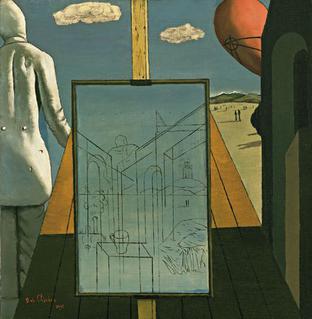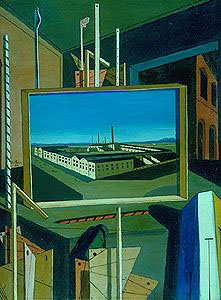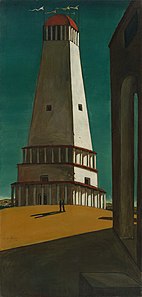 W
WAriadne is a 1913 painting by Greco-Italian artist Giorgio de Chirico. Done in oil and graphite on canvas, the painting depicts the mythical figure Ariadne as she lays sleeping in an empty public square; this is in reference to the myth that birthed the character, in which Ariadne is abandoned on Naxos by her lover Theseus. According to sources provided by the Metropolitan Museum of Art, this reflects de Chirico's personal feelings of isolation after moving to Paris in 1911.
 W
WThe Disquieting Muses is a painting by the Italian metaphysical painter Giorgio de Chirico.
 W
WThe Double Dream of Spring is a painting by the Italian metaphysical painter Giorgio de Chirico.
 W
WThe Enigma of the Hour (1911) is a painting by the Italian metaphysical painter Giorgio de Chirico. He created the work during his early period, in Florence, when he focused on metaphysical depictions of town squares and other urban environments.
 W
WGare Montparnasse (1914) is a painting by the Italian metaphysical painter Giorgio de Chirico. Many of de Chirico's works were inspired by the introspective feelings evoked by travel. He was born in Greece to Italian parents. This work was painted during a period when he lived in Paris.
 W
WThe Melancholy of Departure (1916) is a painting by the Greek-Italian metaphysical painter Giorgio de Chirico. This painting was created after de Chirico returned to Italy from Paris to join the Italian Army in World War I.
 W
WMetaphysical Interior with Biscuits (1916) is a painting by the Italian metaphysical painter Giorgio de Chirico. It is one of the earliest editions in a series of works that extended late into de Chirico's career.
 W
WMetaphysical Interior with Large Factory (1916–17) is a painting by the Italian metaphysical painter Giorgio de Chirico. It is part of a series that extended late into de Chirico’s career.
 W
WThe Nostalgia of the Infinite is a painting by the Italian metaphysical painter Giorgio de Chirico.
 W
WLe Rêve Transformé is a 1913 painting by the Italian metaphysical painter Giorgio De Chirico. This work contains the classic De Chirico's images of an empty urban scene at late evening with a ghostly train on the horizon. In this case in the foreground is an arrangement of bananas, pineapples and a Greek sculpture.
 W
WThe Song of Love is a painting by the Italian metaphysical painter Giorgio de Chirico. It is one of the most famous works by de Chirico and an early example of the surrealist style, though it was painted ten years before the movement was "founded" by André Breton in 1924.
 W
WThe Soothsayer's Recompense is a 1913 painting by the Italian artist Giorgio de Chirico. It is now in the Philadelphia Museum of Art as part of the permanent collection. It was accessioned in 1950 as one of the thousand items donated to the institution by Walter and Louise Arensberg. The piece was created in France, through a process of "squaring-up" in which De Chirico drew a version of the piece divided into nine squares, and subsequently used this draft to quickly create the fleshed-out painting.